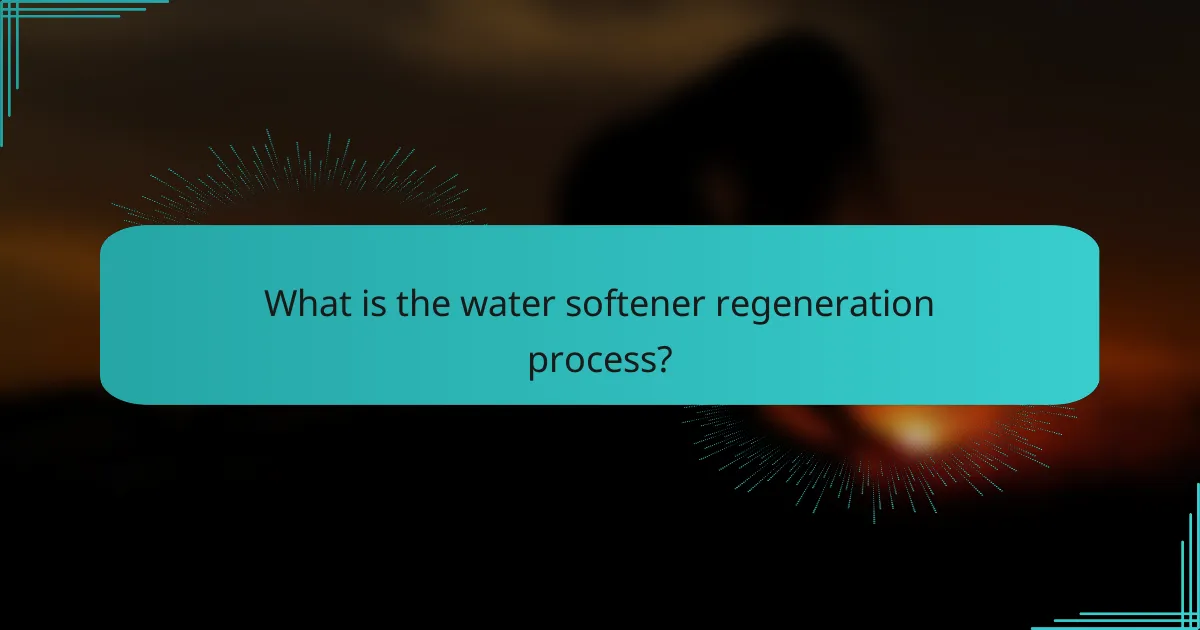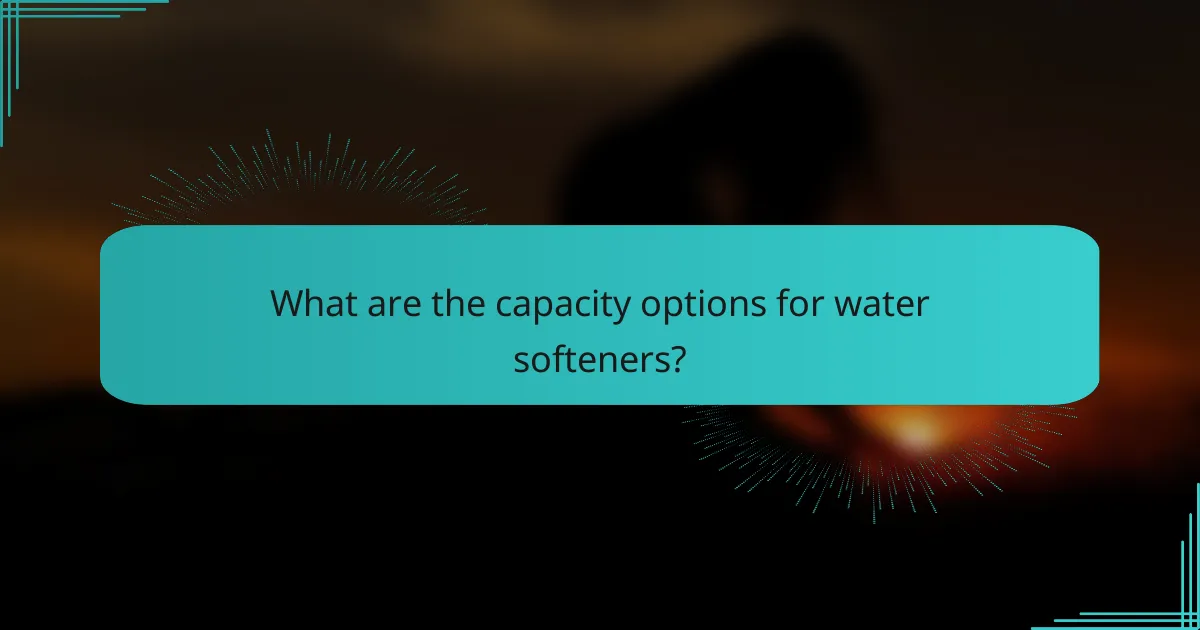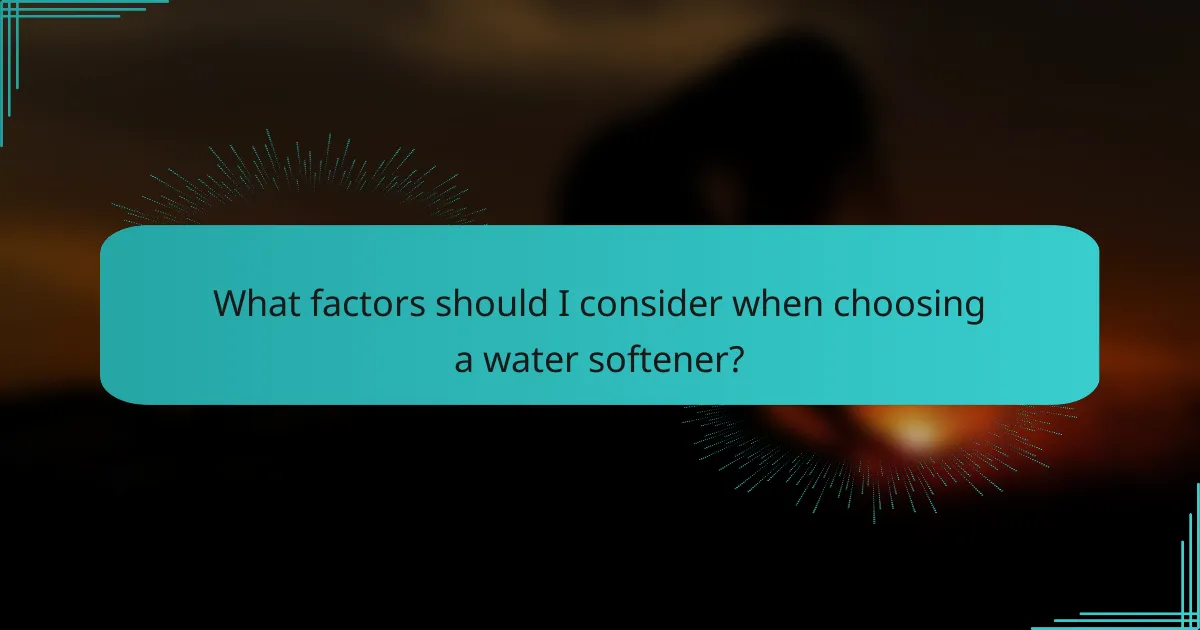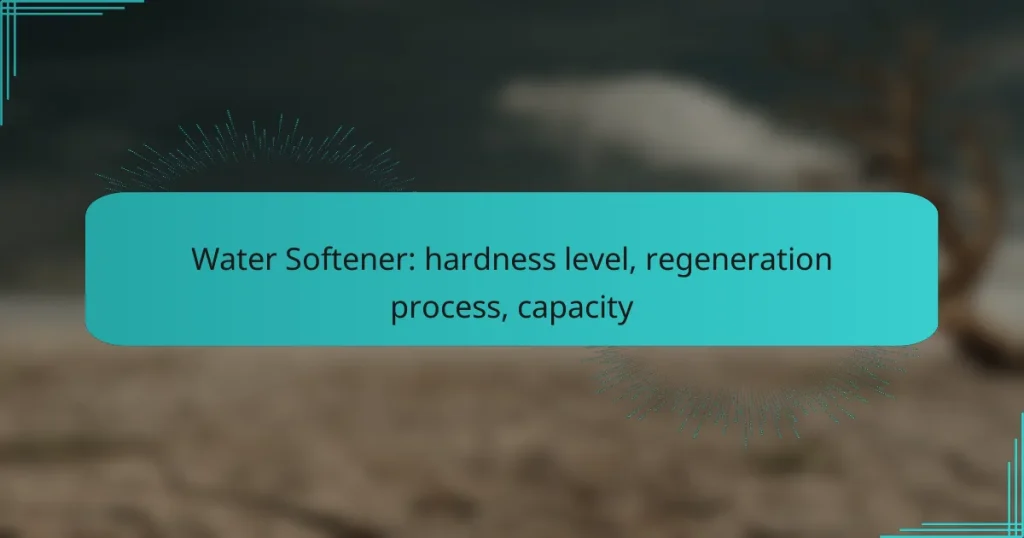Water softeners are essential for households dealing with hard water, which is characterized by high levels of calcium and magnesium that can damage appliances and plumbing. Understanding the hardness level of your water, the regeneration process that replenishes the softener’s effectiveness, and the unit’s capacity are crucial for selecting the right system. An efficient water softener not only reduces mineral content but also minimizes maintenance efforts, ensuring long-term benefits for your home.

What are the best water softeners for hard water in the UK?
The best water softeners for hard water in the UK include models that effectively reduce mineral content while being efficient in their regeneration process. Key factors to consider are capacity, ease of use, and maintenance requirements.
Fleck 5600SXT
The Fleck 5600SXT is a popular choice for households dealing with hard water. It features a digital control head that allows for easy programming and monitoring of the regeneration process, ensuring optimal performance.
This model typically has a capacity ranging from 32,000 to 64,000 grains, making it suitable for medium to large households. Its efficient design minimizes water waste during regeneration, which is a significant advantage for users looking to conserve resources.
EcoWater ECR3500
The EcoWater ECR3500 is designed with advanced technology to provide effective water softening while being environmentally friendly. It uses a unique system that adjusts the regeneration cycle based on actual water usage, which can lead to cost savings on salt and water.
This model generally has a capacity of around 30,000 to 40,000 grains, making it ideal for smaller to medium-sized homes. Its compact design allows for easy installation in tight spaces, and it is known for its reliability and low maintenance needs.
Harvey’s Water Softeners
Harvey’s Water Softeners are well-regarded for their high efficiency and low salt usage. They operate without the need for electricity, making them a practical choice for those looking for a straightforward solution to hard water issues.
These systems typically have capacities ranging from 8,000 to 20,000 grains, catering to various household sizes. Their unique design allows for continuous soft water supply, ensuring that users never run out of softened water during peak usage times.

How does water hardness affect household appliances?
Water hardness significantly impacts household appliances by causing scale buildup and reducing their efficiency. Hard water contains high levels of calcium and magnesium, which can lead to various issues over time.
Increased scale buildup
Hard water contributes to scale buildup in appliances like dishwashers, water heaters, and coffee makers. This mineral deposit can clog pipes and reduce the efficiency of heating elements, leading to higher energy consumption.
Regular descaling is essential to maintain appliance performance. Depending on water hardness, this may need to be done every few months to annually. Using a water softener can help mitigate this issue by reducing mineral content.
Reduced appliance lifespan
Appliances exposed to hard water often experience a shorter lifespan due to the stress caused by scale buildup. The efficiency loss can lead to overheating and mechanical failure, resulting in costly repairs or replacements.
To extend the life of your appliances, consider installing a water softener. This system can significantly reduce the negative effects of hard water, helping appliances operate more efficiently and last longer.

What is the water softener regeneration process?
The water softener regeneration process is essential for restoring the effectiveness of a water softener after it has removed hardness minerals from water. This process typically involves the use of salt to recharge the resin beads that capture these minerals, ensuring the system continues to provide soft water efficiently.
Ion exchange method
The ion exchange method is the primary mechanism used in water softeners to remove hardness minerals like calcium and magnesium. During normal operation, hard water passes through resin beads that are coated with sodium ions. As hard minerals enter the system, they displace the sodium ions, which are then released into the water.
Once the resin beads become saturated with hardness minerals, the regeneration process begins. This involves flushing the beads with a brine solution, allowing sodium ions to replace the captured hardness minerals, thus restoring the beads’ softening capacity.
Brine solution application
The brine solution application is a critical step in the regeneration process. Typically, a concentrated salt solution is prepared using water and salt, which is then introduced to the resin tank. This solution is essential for effectively displacing the hardness minerals from the resin beads.
During this phase, the brine solution flows through the resin, allowing sodium ions to attach to the beads while hardness minerals are washed away. This process usually takes about 30 to 90 minutes, depending on the system’s design and capacity. Afterward, the system may require a rinse cycle to remove excess brine before resuming normal operation.

What are the capacity options for water softeners?
Water softeners come in various capacity options to accommodate different household sizes and water usage. Choosing the right capacity ensures efficient operation and minimizes the frequency of regeneration cycles.
1-2 person household
For a household with one to two people, a water softener with a capacity of around 20,000 to 30,000 grains is typically sufficient. This size can handle the lower water usage, providing soft water for daily activities like bathing and laundry.
When selecting a unit, consider your water hardness level and daily consumption. A smaller capacity unit will regenerate less frequently, saving on salt and water costs.
3-4 person household
Households with three to four members generally require a water softener with a capacity of 30,000 to 40,000 grains. This range accommodates increased water usage for showers, dishwashing, and laundry without compromising effectiveness.
It’s advisable to assess your specific water hardness and usage patterns. Choosing a slightly larger unit can provide a buffer for peak usage times, ensuring consistent soft water availability.
5+ person household
For larger households with five or more people, a capacity of 40,000 to 80,000 grains is recommended. This ensures that the system can handle high water demands, especially during busy times like mornings or weekends.
When selecting a unit, consider the peak water usage and hardness levels. Larger systems may require more salt and water for regeneration, but they also provide the convenience of fewer regeneration cycles, making them ideal for high-demand situations.

What factors should I consider when choosing a water softener?
When choosing a water softener, consider the water hardness level, household size, and regeneration type. These factors will help you select a system that effectively meets your needs and ensures optimal performance.
Water hardness level
The water hardness level is a critical factor in selecting a water softener, as it determines how much hardness the system needs to remove. Water hardness is typically measured in grains per gallon (gpg) or parts per million (ppm), with levels ranging from soft (0-3 gpg) to very hard (over 10 gpg). Knowing your local water hardness can help you choose a system with the right capacity.
To find out your water hardness, you can use a test kit or check with your local water utility. For example, if your water hardness is in the high range, you may need a more powerful softener or one with a larger capacity to handle the demand.
Household size
Household size significantly impacts the choice of a water softener, as larger families typically require systems with higher flow rates and capacities. A general rule of thumb is to consider the number of people in your home and their daily water usage. For instance, a family of four may need a softener that can handle 30,000 to 40,000 grains of hardness removal.
When assessing your household size, also consider peak usage times, such as mornings or evenings, when multiple appliances may be in use simultaneously. This will help ensure that your water softener can meet your household’s demands without running out of softened water.
Regeneration type
The regeneration type of a water softener refers to how it cleans and replenishes its resin beads after they have removed hardness minerals. There are two main types: time-initiated and demand-initiated regeneration. Time-initiated systems regenerate at set intervals, while demand-initiated systems regenerate based on actual water usage, which can be more efficient.
Choosing the right regeneration type can affect both water quality and operational costs. Demand-initiated systems tend to use less salt and water, making them a more economical choice for many households. Consider your family’s water usage patterns when deciding which type is best for you.

How often should a water softener regenerate?
A water softener typically regenerates every few days, depending on its settings and water usage. This process is essential for maintaining its effectiveness in removing hardness minerals from the water supply.
Every 2-3 days
Many water softeners are programmed to regenerate every 2 to 3 days, especially in households with average water hardness and usage. This frequency helps ensure that the resin beads remain effective in softening water by replenishing the sodium ions that replace hardness minerals.
However, the exact timing can vary based on the unit’s capacity and the hardness level of the incoming water. Regular maintenance checks can help determine if adjustments are needed for optimal performance.
Based on water usage
The regeneration frequency can also be adjusted based on actual water usage. If a household consumes more water than average, the softener may need to regenerate more frequently to keep up with demand. Monitoring water usage can provide insights into whether the current settings are adequate.
For instance, families with higher water consumption may find that regenerating every day or two is necessary, while smaller households might only need to regenerate once a week. It’s beneficial to track water usage to optimize the regeneration schedule and avoid unnecessary salt consumption.

What are the costs associated with water softeners in the UK?
The costs associated with water softeners in the UK include the initial purchase price, installation fees, and ongoing maintenance expenses. Understanding these costs can help you make an informed decision about investing in a water softener system.
Initial purchase price
The initial purchase price of a water softener in the UK typically ranges from £400 to £1,500, depending on the type and capacity of the unit. Basic models may be less expensive, while high-capacity or advanced systems can be significantly pricier.
When selecting a water softener, consider factors such as the hardness level of your water, household size, and specific features you may need. Investing in a higher-quality unit can lead to better performance and longevity.
Additionally, some brands offer extended warranties or service plans that can affect the overall cost. It’s advisable to compare different models and read customer reviews to ensure you’re getting good value for your investment.


